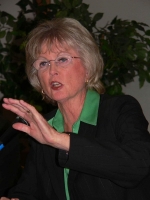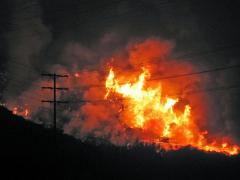Backcountry residents burned up over latest tactic to grab land before court cases on Powerlink are heard
March 8, 2010 (San Diego’s East County) – Aiming to begin construction on Sunrise Powerlink this summer, San Diego Gas & Electric Company (SDG&E) is going to court to seek eminent domain powers to force landowners to turn over as many as 80 properties to the utility for construction of the controversial high-voltage power line. The tactic has sparked outrage among many East County residents.
“Considering that the Sunrise Powerlink has two major lawsuits in federal and state court, either of which could halt construction of this project, I think it is abusive and an irresponsible use of ratepayer money to expend resources on a project that may never be built. Who will pick up these costs once the project is terminated? Ratepayers,” Laura Cyphert, cofounder of the East County Community Action Coalition (www.eastcountyaction.org) , told East County Magazine. ECCAC is a coalition representing over 79,000 people in the battle to halt Powerlink.
 Supervisor Dianne Jacob also criticized the utility’s actions before legal cases that could stop the project are heard by the courts.
Supervisor Dianne Jacob also criticized the utility’s actions before legal cases that could stop the project are heard by the courts.
“Why take people’s land when we don’t know for sure if this line is going forward?” she said, according to an article in today’s San Diego Union-Tribune. Jacob called the move “troubling.”
The project could also be blocked if Cleveland National Forest supervisor Willian Metz refuses to grant approval for Powerlink to cross federal forest lands. The majority of the route is on federal property, including national forest and Bureau of Land Management tracts.
SDG&E says the eminent domain actions begun last week are a last resort prior to its plans to commence construction in June. “We have placed orders for key components, including towers and underground cable, and are now focused on completing the construction agreements and acquiring land rights,” Don Felsinger, chief executive of parent company Sempra Energy, has stated.
The utility has made offers to about 60 of the 80 landowners and agreed to prices with 22, the Union-Tribune reports. Seven landowners have gone to court. An

attorney for some of the property owners, told the Union-Tribune that besides being forced to sell their homes, some are being offered an “unfair price that just adds insult to injury.”
The California Public Utilities Commission (CPUC) approved the Powerlink project. One lawsuit seeks to overturn that decision on environmental and fire issues. Another suit challenges the BLM approval.
Katheryn Rhodes, a civil engineer, and Conrad Hartsell, MD have written to the CPUC to request a meeting with Cleveland National Forest officials, CAL-FIRE, and other public officials on fire safety issues. They contend that the full southern route of Powerlink was never adequately analyzed in the Environmental Impact Report.
“In the draft EIR, Mr. William Metz, the Cleveland National Forest Supervisor, recommended such a meeting before the final EIR was published,” their letter noted. Rhodes and Hartsell further contend that at a meeting with CAL-FIRE officials in San Diego, “CAL-FIRE agreed with us that incorrect FRAP (Fire Resource Assessment Program) maps were used, and that CAL-FIRE would love the opoprtunit to meet with SDG&E, Sempra, CPUC, Aspen Environmental, and the Cleveland National Forest officials to discuss our outstanding concerns.” They added that Sempra, SDG&E and the CPUC falsely implied that CAL-FIRE approved the existing fire analysis.
The CPUC has declined their request for the meeting. In a letter of response, the CPUC argued that a full analysis of the southern route was completed “albeit in separate sections” and that a “wildfire modeling effort was carried out.” However it subsequently notes that fire and ignition history data was used “in a limited manner” relying solely on vegetation characteristics collected during limited weeks. “Historic fire perimeters and ignitions data were not used in these two models,” the CPUC admitted.
Cyphert ridiculed the CPUC response. “In a nutshell,” she observed, “the CPUC acknowledged that they used incomplete Cal Fire maps, but further stated that this did not matter, because they didn’t rely on the data, and the reasons they did not rely on the data is that due to the topography and brush in this rea, it has been classified as “non-defensible” and therefore it makes no difference if there are transmission lines, because the firefighters can’t fight there anyway.”
 Moreover, she argued, “fires in this area are successfully defended every year. Even the Fire Marshall for the Sunrise Powerlink, Acree Shreve, stated to me that he has successfully defended this area many times in his personal history fighting wild land fires.”
Moreover, she argued, “fires in this area are successfully defended every year. Even the Fire Marshall for the Sunrise Powerlink, Acree Shreve, stated to me that he has successfully defended this area many times in his personal history fighting wild land fires.”
She cited additional “shocking admissions” in CPUC documents, including an admission that a wildfire started along the El Capitan fireshed section of the Interstate 8 route alternative during Santa Ana conditions “would obstruct this main transportation and evacuation corridor through the region.”
Besides lawsuits already filed, San Diego County is also fighting back against the Powerline. County planners say SDG&E hasn’t explained where it will get millions of gallons of water needed for construction in an area where residents are reliant on groundwater, or how its lines will impact County parks and other County lands.
Landowners facing eminent domain, the taking of their land for a public project, have the right to go to court and ask a jury to determine a fair price for their properties.
McKinley, the attorney representing landowners facing eminent domain, believes jurors won’t be swayed by SDG&E’s power play tactics. “Juries who listen to this and see the simulations of what it looks like with the towers and the lines,” he concluded. “They’re going to sympathize with the property owner.”
But for property owners faced with losing lands that they love in some of East County’s most scenic backcountry areas, receiving a fair price may seem small consolation for their losses.








Recent comments